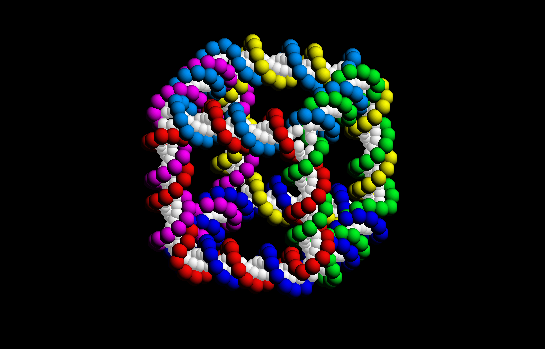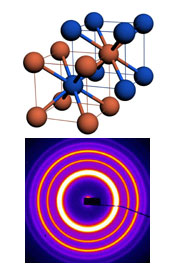 A lot of interesting work has been done with DNA nanotechnology, much of it starting with Nadrian Seeman's work on DNA polyhedra in the mid-90s (1, 2).
A lot of interesting work has been done with DNA nanotechnology, much of it starting with Nadrian Seeman's work on DNA polyhedra in the mid-90s (1, 2).Around 2000, Andrew Turberfield (Oxford University's Department of Physics) used DNA to make tweezers, with arms 7 nanometers long.
"Of course it's all very speculative," said Dr Turberfield, "but you can imagine, for instance, little factories on chips doing chemistry or simple assembly. You can think of production lines made up of little motors with different reactants being passed from one place to the next."
 Things got really interesting in March 2006 with Paul Rothemund's DNA origami technique. Here is the publication. I was working at Nanorex at that time, and we were all quite excited about it.
Things got really interesting in March 2006 with Paul Rothemund's DNA origami technique. Here is the publication. I was working at Nanorex at that time, and we were all quite excited about it. In 2005 Turberfield and colleagues described a family of DNA tetrahedra consisting of triangles of DNA helices covalently joined at the vertices to form a mechanically rigid 3D structure. This image of a reduced model of one structure, which is less than 10 nanometers on a side, was created using NanoEngineer-1 Alpha 9. The bowing of the DNA helices is pronounced in this rendering and is the result of electrostatic potential terms included in the customized molecular-mechanics-like force field developed by Dr. K. Eric Drexler specifically for DNA structures. Regarding Turberfield's work, New Scientist wrote:
In 2005 Turberfield and colleagues described a family of DNA tetrahedra consisting of triangles of DNA helices covalently joined at the vertices to form a mechanically rigid 3D structure. This image of a reduced model of one structure, which is less than 10 nanometers on a side, was created using NanoEngineer-1 Alpha 9. The bowing of the DNA helices is pronounced in this rendering and is the result of electrostatic potential terms included in the customized molecular-mechanics-like force field developed by Dr. K. Eric Drexler specifically for DNA structures. Regarding Turberfield's work, New Scientist wrote:Now Andrew Turberfield [et al] have shown how carefully crafted DNA structures can be made to self assemble and change shape when sent specific DNA signals. The researchers built tetrahedrons ... using four short DNA "struts" that join at each end. The process exploits the way DNA is held together by complementary bases that form the rungs of a ladder-like structure ... the researchers made cages with two extendible struts that could be independently controlled using different DNA sequences. In theory, it should be possible to create cages in which every strut can be controlled independently, Tuberfield says.These cages are a combination of support material and linear motor, and with the many other DNA tricks being done, they should allow people to build large, complicated, reasonably rigid 3D structures that have controllable moving parts. So this is a very promising development.
 A very recent announcement of work by Chad Mirkin and colleagues. They have found a way to use DNA to glue together arbitrary arrangements of teeny gold spheres. People have known for some time now how to make DNA stick to gold spheres, and by careful selection of DNA sequences, Mirkin et al can position groups of spheres in almost any 3D configuration they want.
A very recent announcement of work by Chad Mirkin and colleagues. They have found a way to use DNA to glue together arbitrary arrangements of teeny gold spheres. People have known for some time now how to make DNA stick to gold spheres, and by careful selection of DNA sequences, Mirkin et al can position groups of spheres in almost any 3D configuration they want.In light of these developments, Nanorex has narrowed its focus from "general" nanotechnology (anything one might build from common small molecules) to structural DNA nanotechnology. This is likely to be where much progress will occur in the next five years or so. I hope Nanorex will still be around after that, and will be in a good position to shift gears as we move beyond DNA to more general chemistry.
No comments:
Post a Comment